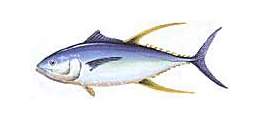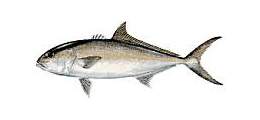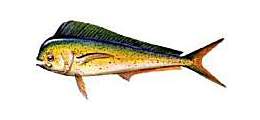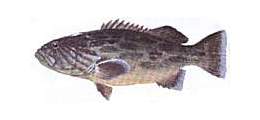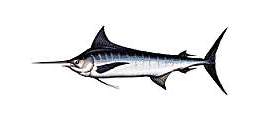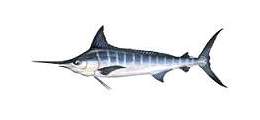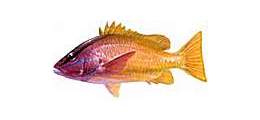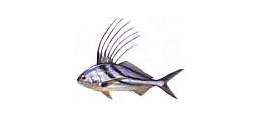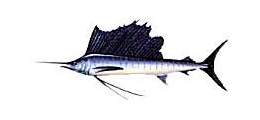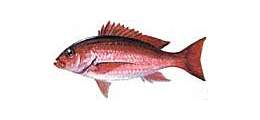| |
Riviera Nayarit Sportfishing Calendar

Anytime of the year is a great time for sportfishing in Banderas Bay, but certain times of the year are better than others for certain types of fish.
Our fishing calendar represents historical average conditions for preceeding years based on captains' observations. However, water temperature variations and other factors can create seasons different than those represented here.
Place your mouse on each fish for a larger view and brief description.
Click on each fish image for more information on each fish.
| |
Place your
mouse over
each fish for
a larger view. |
Jan |
Feb |
Mar |
Apr |
May |
Jun |
Jul |
Aug |
Sep |
Oct |
Nov |
Dec |
Tuna
(Atun) |
 |
 |
 |
 |
 |
 |
 |
 |
 |
 |
 |
 |
 |
Amberjack
(Pez Fuerte) |
 |
 |
 |
 |
 |
 |
 |
 |
 |
 |
 |
 |
 |
Dorado
(Mahi Mahi) |
 |
 |
 |
 |
 |
 |
 |
 |
 |
 |
 |
 |
 |
Grouper
(Garlopa) |
 |
 |
 |
 |
 |
 |
 |
 |
 |
 |
 |
 |
 |
Crevalle Jack
(Toro) |
 |
 |
 |
 |
 |
 |
 |
 |
 |
 |
 |
 |
 |
| Blue Marlin |
 |
 |
 |
 |
 |
 |
 |
 |
 |
 |
 |
 |
 |
| Black Marlin |
 |
 |
 |
 |
 |
 |
 |
 |
 |
 |
 |
 |
 |
| Striped Marlin |
 |
 |
 |
 |
 |
 |
 |
 |
 |
 |
 |
 |
 |
Pargo
(Coconaco) |
 |
 |
 |
 |
 |
 |
 |
 |
 |
 |
 |
 |
 |
Roosterfish
(Pez Gallo) |
 |
 |
 |
 |
 |
 |
 |
 |
 |
 |
 |
 |
 |
Sailfish
(Pez Vela) |
 |
 |
 |
 |
 |
 |
 |
 |
 |
 |
 |
 |
 |
Sierra
(Span. Mackerel) |
 |
 |
 |
 |
 |
 |
 |
 |
 |
 |
 |
 |
 |
Snapper
(Huachinago) |
 |
 |
 |
 |
 |
 |
 |
 |
 |
 |
 |
 |
 |
Wahoo
(Ghaho Peto) |
 |
 |
 |
 |
 |
 |
 |
 |
 |
 |
 |
 |
 |
Riviera Nayarit Gamefish Descriptions
AMBERJACK (Seriola dumerili)
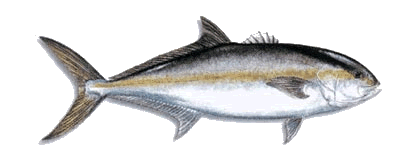 OTHER NAMES: Amberfish, AJ, Coronado, Cavilia OTHER NAMES: Amberfish, AJ, Coronado, Cavilia
RANGE: Mexican Coastal Waters, Eastern Pacific. Carribean
HABITAT: Adults are common at various depths, ranging from reefs several hundred feet deep to fairly shallow wrecks and reefs. Big ones also come close to shore at times, particularly in the Keys and the Islands. Artificial reefs and wrecks all along the Gulf Coast often harbor huge schools of smaller Amberjack, and many Gulf wrecks are home to big ones as well.
DESCRIPTION: Overall brownish or goldish. Heavy body. No scutes forward of tail fin. Dark oblique line through the eye that ends at the dorsal fin.
SIZE: Schools of young fish are common at 5-20 pounds. Average size over deep wrecks and reefs is 30-60 pounds, but 100-pounders are not too rare and the potential maximum exceeds 150 pounds. World record 155 pounds, 10 ounces; Florida record 142 pounds.
FOOD VALUE: Excellent, smoked or fresh.
GAME QUALITIES: A strong, punishing fighter that powers deep and defies lifting. Fairly long runs can also occur early in the fight. A great deal of stamina matches their strength. Novices may fight Amberjack of average size for an hour or longer.
TACKLE AND BAITS: Amberjack are most often caught aboard charterboats and partyboats on heavy rods and reels with lines testing 50 pounds or more and are no patsies, even then. Experienced light-tackle anglers can successfully battle them with spinning and baitcasting rigs, and even fly rods. Around wrecks, they frequently follow hooked fish to boatside, and also may rise to the top voluntarily. Then they can be cast to with surface plugs, spoons, jigs, or big flyrod streamers and poppers. Live chum will also draw Amberjack from the depths. Best bait with heavy tackle is any sort of live fish, the friskier the better.
FISHING SYSTEMS: Casting; Drifting; Trolling.
Back to Top
DORADO (Coryphaena hippurus)
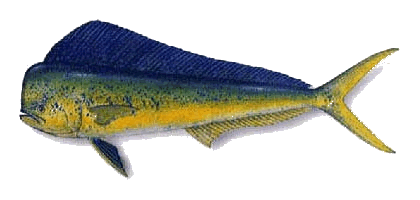 OTHER NAMES: Dolphin, Mahi Mahi OTHER NAMES: Dolphin, Mahi Mahi
RANGE: Mexican Coastal Waters
HABITAT: Dolphin ream the open sea in a continuous hunt for food. Anglers seek them along rafted weedlines and around any sort of large floating object. The location of schools may also be given away by feeding birds, particularly frigate birds.
DESCRIPTION: A blaze of blue and yellow or deep green and yellow when in the water, and sometimes shows dark vertical stripes as well when excited. Small dark spots on sides. Dorsal fin extends nearly from head to tail. Head is very blunt in males (bulls); rounded in females (cows). The Pompano Dolphin, Coryphaena equisetis, is often mistaken as a female or juvenile male Dolphin. It is found in most of the same waters, grows to about 5 pounds and can be distinguished by the rounded shape of the underbelly.
SIZE: Schooling fish run in similar sizes, from around a pound to nearly 20 pounds at times; larger fish are loners, or else pairs bull and cow. Big bulls often reach 50 pounds in weight and can exceed 80 pounds on rare occasion. Large cows generally top out at 40 pounds or so. World record 87 pounds.
FOOD VALUE: None better.
GAME QUALITIES: Top of the heap in any weight class speedy. Strong and acrobatic.
TACKLE AND BAITS: With the Dorados, anything goes. Private-boat anglers seek to find a school by trolling or by running and searching for visual signs. Once a school is located, it can usually be kept around the boat by restrained chumming with cut bait and/or by keeping at least one hooked fish in the water at all times. A hot school will eagerly accept jigs and all sorts of casting baits, including flies and popping bugs. If strikes slow down, cut bait often does the trick. Big or wise fish may insist on live baits. Countless Dolphin are also caught, both by design and incidentally, on the entire gamut of rigged trolling baits and artificial trolling lures.
FISHING SYSTEMS: Casting; Drifting; Trolling.
Back to Top
GROUPER (Mycteroperca bonaci)
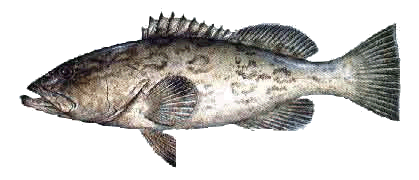 OTHER NAMES: Bonaci, Arara, Aguaji OTHER NAMES: Bonaci, Arara, Aguaji
RANGE: Mexican Coastal Waters, Pacific Coast, Deep Waters
HABITAT: Groupers of many sizes and varieties are commonly found around the edges of coral reefs and rocks, from about 30 feet of water out to the deepest dropoffs. Even big fish, however, may roam to much shallower patch reefs, especially in cooler seasons. Small Blacks may also frequent creeks in some areas.
DESCRIPTION: Overall color is dark gray. Markings are blacker than those of the Gag, and form box-like patterns. Fins are black; their edges also black or deep blue.
SIZE: The largest of our Mycteroperca groupers, the Black frequently exceeds 50 pounds in weight and can top 100. World record 114 pounds.
FOOD VALUE: Excellent. Yum Yum!!
GAME QUALITIES: Nice fighter - Black Groupers are considered the best of the family.
TACKLE AND BAITS: For all-around work, ocean gear with lines of 30-pound test or higher gets the call. Light-tackle fishermen in Banderas Bay, however, have caught many Blacks over 50 pounds. One key besides a huge helping of luck is to hook the fish while drifting, instead of at anchor. The drift of the boat adds to the power of the tackle and just might help drag the big fish far enough away from his rocky "hole" that he cannot get back. For drifting or still fishing, the best baits are frisky live fish, such as Blue Runners or other small jacks. Pinfish and Pilchards are good too, as are Mullet heads and other large cut baits. Best casting lures are leadhead jigs, weighing from 1-4 ounces, depending on depth. Trolling over the reefs with rigged, swimming Mullet, feather-and-strip combos, and large plugs also takes many.
FISHING SYSTEMS: Drifting; Still Fishing; Trolling.
Back to Top
CREVALLE JACK (Caranx hippos)
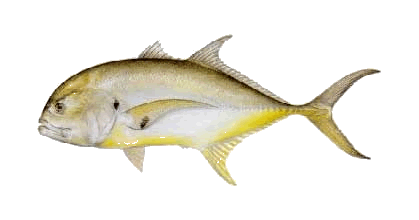 OTHER NAMES: Jack Crevalle, Crevally OTHER NAMES: Jack Crevalle, Crevally
RANGE: Mexican Coastal Waters, Eastern Pacific. Carribean
HABITAT: The Crevalle may show up at any time in virtually all Mexican waters, from the deep reefs to well up coastal rivers. Usually runs in schools and the smaller the individual fish, the larger the school. The biggest Jacks often cruise in pairs and are usually found in or near major inlets and around offshore wrecks and reefs of both coasts, but may come into deep bays and canals where they chase Mullet and often herd the prey against seawalls. Banderas Bay has a large population of this species.
DESCRIPTION: Deep, compressed body. Blunt head with black spot on rear edge of gill cover. Hard scutes forward of sickle-shaped tail. Color usually yellowish with white undersides.
SIZE: Common at 1 pound or less to about 5 or 6 pounds. Plentiful up to 12 pounds in most areas. Sometimes tops 20 pounds and can reach 50 pounds or even more. World record is 57 pounds.
FOOD VALUE: Poor by most tastes. Most of the meat is dark red and of strong flavor. A delicasy for our fine finned friends however.
GAME QUALITIES: Few fish can out-pull a Crevalle of equal size. The fight is unspectacular but dogged, the usual pattern being a long first run. Jacks use their flat sides to good advantage when waging a tug-o-war.
TACKLE AND BAITS: Most Jacks are fairly small and are caught on the full range of light tackle by anglers seeking other game. If you target larger Jacks, say 10 pounds or more, sturdy spinning, baitcasting and fly tackle should be used, with lines no less than 8-pound test. Small Jacks, such as those frequently encountered on shallow flats, will gulp down almost any sort of natural bait, live or dead, as well as all the popular casting and flyrod lures. Big Crevalles, however, generally like their meals moving very fast. To assure hookups, you have to use fresh and frisky live fish, or retrieve your artificial lures rapidly, noisily, or both. Topwater plugs are good, as are fast-whipped jigs. Fly rodders often have to work very hard, stripping their streamers or poppers as fast as their elbows will move.
FISHING SYSTEMS: Casting; Drifting; Still Fishing; Trolling.
Back to Top
BLUE MARLIN (Makaira nigricans)
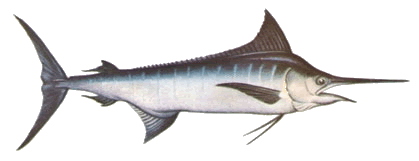 OTHER NAMES: Aguja Azul OTHER NAMES: Aguja Azul
RANGE: Mexican Deep Waters, Eastern Pacific, Carribean
HABITAT: A free-roamer that is best fished where bait is most plentiful -along weed lines; around schools of small tuna and other pelagic baitfishes; in areas where seamounts or other sub-surface structure creates up wellings and current; sharp bottom contours; temperature changes.
DESCRIPTION: Coloration varies a great deal. Most common phase is dark blue, almost black on the dorsal surface, shading to whitish. Usually, several vertical stripes are noticeable. Early in the 20th century, these variations led anglers to believe several species were involved. Science eventually determined that the Black and Striped Marlins are strictly Pacific species and that a Silver Marlin is non-existent. The Blue, however, is found in both hemispheres. The feature that distinguishes the Blue from others is the pointed dorsal fin that curves sharply downward. The anal fin and pectoral fins also are pointed.
SIZE: From about 150 pounds to 500; not rare over 500. World record 1,402 pounds
FOOD VALUE: Good, but normally released by sportsmen.
GAME QUALITIES: Best of all for speed, power and jumping ability. A real fighter.
TACKLE AND BAITS: While many Blues have been caught on lighter outfits, the standard is a good balanced ocean trolling outfit in the 5-pound or even 80-pound line class. Marlin baits fall into three categories: 1. Artificial trolling lures; 2. Live, fairly large baitfish, such as school Dolphin or Bonito; and 3. Rigged natural baits, such as Mullet, Mackerel, Bonito, Barracuda, extra-large Ballyhoo ("Horse Ballyhoo"). Lures are used most often, because they allow more ocean to be covered. In somewhat limited areas, such as along weedlines or around seamounts and other well-established grounds, live bait is usually preferred.
FISHING SYSTEMS: Drifting; Trolling.
Back to Top
BLACK MARLIN (Makaira indicus)
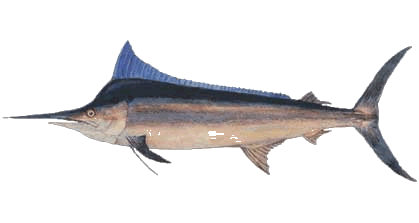 OTHER NAMES: Pacific black marlin, giant black marlin (Hawaii), white marlin (Japan) OTHER NAMES: Pacific black marlin, giant black marlin (Hawaii), white marlin (Japan)
RANGE: Mexican Deep Waters, Eastern Pacific, Carribean
HABITAT: Black marlin generally exist in the tropical and sub-tropical regions of the Pacific and Indian Oceans. They are a highly migratory, pelagic species that will rarely swim deeper than 100 feet. They are most commonly found in deep waters, near such prominent bottom structures as continental shelves and reefs.
DESCRIPTION: The black marlin is the only marlin with non-retractable fins. Another distinguishing trait is their dorsal fin which is proportionately the lowest of any billfish. It stands less than 50 percent of the fish's body height. The black marlin's back is slate blue and transitions to a silver belly. It may also have light blue stripes when excited.
SIZE: World Record 1560 lbs. These are big fish!!
FOOD VALUE: Good, but normally released by sportsmen.
GAME QUALITIES: The black's immense strength and exceptional size makes it a favored target among big-game fishermen. A fight with one of these fish can last for hours, wearing severely on the angler as well as the tackle. Anglers commonly troll brightly colored lures or rigged baitfish to catch this species. As a result of the depleted stocks, many sport fisherman are now tagging and releasing their catches.
TACKLE AND BAITS: While many Blacks have been caught on lighter outfits, the standard is a good balanced ocean trolling outfit in the 5-pound or even 80-pound line class. Marlin baits fall into three categories: 1. Artificial trolling lures; 2. Live, fairly large baitfish, such as school Dolphin or Bonito; and 3. Rigged natural baits, such as Mullet, Mackerel, Bonito, Barracuda, extra-large Ballyhoo ("Horse Ballyhoo"). Lures are used most often, because they allow more ocean to be covered. In somewhat limited areas, such as along weedlines or around seamounts and other well-established grounds, live bait is usually preferred.
FISHING SYSTEMS: Sometimes Drifting; Trolling.
Back to Top
STRIPED MARLIN (Tetrapturus audax)
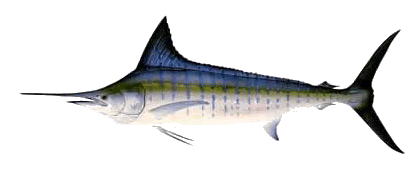 OTHER NAMES: Striper, Marlin, Pacific Marlin, Spikefish, Spearfish. OTHER NAMES: Striper, Marlin, Pacific Marlin, Spikefish, Spearfish.
RANGE: Mexican Deep Waters, Eastern Pacific, Carribean
HABITAT: Striped marlin occur in tropical and warm temperature waters of the Indian and Pacific Oceans. On the west coast of the Mexico and The U.S. they range as far north as Oregon, but are most common south of Point Conception, California. They usually appear off Mexico in July and remain until late October.
DESCRIPTION: The body of the striped marlin is elongate and compressed. The upper jaw is much extended, forming a rounded spear. The color is dark blue above becoming silver below, with light blue bars or vertical spots on the sides.
SIZE: World Record 339 pounds. These are smaller than the Blues and Blacks, but well worth the fight they'll give you.
FOOD VALUE: Good, but normally released by sportsmen.
GAME QUALITIES: Outstanding for speed, power and jumping ability. All Marlins are big fighters.
TACKLE AND BAITS: Most striped marlin are taken by trolling artificial lures in areas they are known to inhabit. Blind strikes are generally the rule, but one can occasionally tempt a "finner" or "sleeper" (marlin swimming along the surface) to strike if lures are trolled past the fish. Live bait also works well but requires more effort since the fish must usually be first spotted visually. Once a striped marlin is located, the angler should cast a bait in front of and past the fish so it can be reeled back towards the animal. Strikes usually result from properly presented live bait. Most striped marlin anglers prefer Pacific mackeral as bait.
FISHING SYSTEMS: Drifting; Trolling.
Back to Top
PARGO (Lutjanus campechanus)
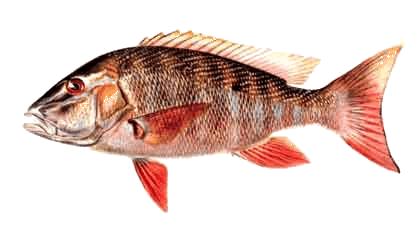 OTHER NAMES: North American, Red Snapper, Genuine Red, OTHER NAMES: North American, Red Snapper, Genuine Red,
RANGE: It is standard bottom-fishing fare, Mexican Deep Waters, Eastern Pacific. Carribean
HABITAT: Pargos are sometimes found in fairly shallow water off the beaches, and even in deep holes of the larger bays like ours.
DESCRIPTION: Overall rosy red. Canine teeth less prominent than those of most other Snappers. Red eye. Anal fin is triangular.
SIZE: Common from a pound or so to about 6 or 8 pounds. Usual maximum is about 20 pounds, although the Red Snapper can rarely run as high as 30 or 40 pounds. World record 50 pounds.
FOOD VALUE: Excellent at all sizes.
GAME QUALITIES: A hard-fighting fish that uses strong, head-shaking tactics rather than long runs.
TACKLE AND BAITS: Some Red Snapper spots in fairly shallow water, say up to 50 or 60 feet, permit the use of light ocean tackle, or even heavy spinning and baitcasting tackle. Much Snapper fishing, however-trips from Panhandle ports requires deep drops in strong currents. This means that only very heavy rods and strong lines of 50- or 80-pound test can handle the heavy weights needed to do the job. As for baits, dead Cigar Minnows, Pilchards or cut fish and squid do well at times, although in heavily fished spots (which most are these days) it will probably be necessary to use live small baitfish to coax bites from Snappers of decent size.
FISHING SYSTEMS: Casting; Drifting; Still Fishing.
Back to Top
ROOSTERFISH (Nemastistius Pectoralis)
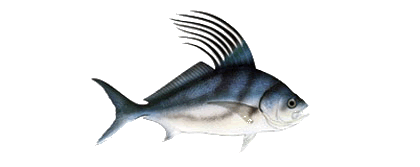 OTHER NAMES: Pez gallo, papagallo OTHER NAMES: Pez gallo, papagallo
RANGE: Pacific Ocean, Sea of Cortez
HABITAT: Surf and Rocky areas offshore. Can also be found near islands and reefs.
DESCRIPTION: Gray back, silver body with two pronounced diagonal stripes. Pectoral fin long and sickle shaped, dorsal fin very elongated and supposedly has a likeness to a rooster's comb, hence the common name. Tail fin is deeply forked as is typical of all members of the jack family.
SIZE: 10 to 30 lb. average, but can reach 100 lb. World and Mexican Record is 114 lb.
FOOD VALUE: Not the best, but certainly not the worst.
GAME QUALITIES: An angler will see the roosterfish come up on and boil on the trolled bait. They will typically circle and whack at the offering before actually crashing on it. A furious fighter with unequaled stamina, unpredictable slashing moves, jumps and long screaming runs.
TACKLE AND BAITS: live bait, with mullet and sardinas their favorite. Rarely taken on lures, but when feeding will hit surface jigs.
FISHING SYSTEMS: Casting; Drifting; Still Fishing.
Back to Top
SAILFISH (Istiophorus platypterus)
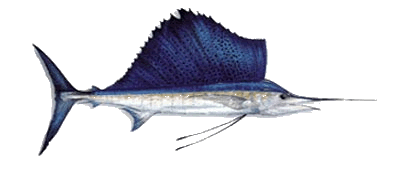 OTHER NAMES: Atlantic Sailfish, Spindlebeak, Pez Vela OTHER NAMES: Atlantic Sailfish, Spindlebeak, Pez Vela
RANGE: Mexican Coastal Waters, Eastern Pacific, Carribean
HABITAT: Like the other Billfishes, the Sailfish is considered an ocean species, but generally can be found closer to land than the rest, seeming to prefer areas where coral reefs and/or freshwater runoffs mingle with ocean water.
DESCRIPTION: Upper surfaces usually dark blue to black; silvery below; vertical stripes often visible on sides.
SIZE: Averages 30-60 pounds, but many under 30 pounds and a few up to 100 pounds are also taken. World record 221 pounds.
FOOD VALUE: Very good broiled or smoked, and should be kept if inadvertently killed. Protected commercially.
GAME QUALITIES: Unsurpassed in its size range for combined strength and spectacle.
TACKLE AND BAITS: Light ocean trolling or heavy spinning outfits with lines up to 30-pound test; 12- and 20-pound lines are adequate in experienced hands and provide great sport. In Southeast Florida, live-baiting - either by kite fishing or flatline drifting - has become perhaps the most popular approach to sailfishing, with Blue Runners, Goggle-eyes, Pilchards or Pinfish being the common offerings. Historically, most Sailfishing has been done with rigged trolling baits, mainly Ballyhoo and strips of Bonito or other small fish. Many Sailfish have been caught on jigs and on drifted Ballyhoo/jig combinations. Fly casters have also taken them on occasion, but Atlantic sails do not decoy as readily as their Pacific counterparts and so fly fishing for them has not become very popular - despite the fact that science has proclaimed the Sailfish of both oceans to be the same species.
FISHING SYSTEMS: Occasionally Casting; Drifting; Trolling.
Back to Top
SIERRA (Scomberomorus maculatus)
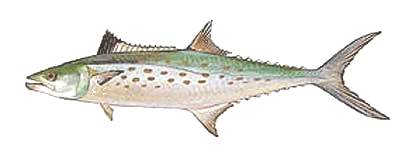 OTHER NAMES: Spanish Mackerel OTHER NAMES: Spanish Mackerel
RANGE: Mexican Deep Waters, Eastern Pacific, Carribean
HABITAT: Largely coastal, but roams offshore at times.
DESCRIPTION: Dark above with silvery sides. Many spots, which are both yellow and brown. The body is proportionately deeper than with juvenile King Mackerel, and the yellow spots appear rounder and brighter, but if in doubt, the only true identifier is the lateral line, which tapers rather gently from front to back with no severe dip.
SIZE: Common at 1-3 pounds; not too unusual at 5-7 pounds; maximum potential over 10 pounds. World record 13 pounds.
FOOD VALUE: If you like rich, rather dark fillets, they are great broiled or skinned and fried. Good smoked, too.
GAME QUALITIES: Outstanding on light tackle; very fast runs.
TACKLE AND BAITS: Spinning, baitcasting and fly outfits. Spinning is often best because the faster retrieve of a spinning reel is sometimes needed to move a lure at a pace that will interest the Mackerel. Best lures are small white nylon jigs and silver spoons, but many others work, including topwater at times. Flies should be small with lots of flash. Best baits are small silvery baitfish, live shrimp and drifted strips.
FISHING SYSTEMS: Drifting; Still Fishing; Trolling.
Back to Top
SNAPPER (Lutjanus buccanella)
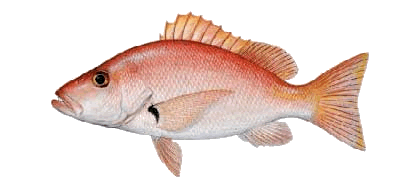 OTHER NAMES: Blackspot, Snapper, Bahamas Red, Snapper OTHER NAMES: Blackspot, Snapper, Bahamas Red, Snapper
RANGE: Mexican Pacific Ocean, Sea of Cortez
HABITAT: Nearly all are caught along outside dropoffs at depths of 200 feet or greater. Roams the deep blue water, but anglers can find them by working dropoffs, seamounts, weedlines and other favorable feeding locations.
DESCRIPTION: Vivid red overall, with black crescent-shaped mark at base of the pectoral fin.
SIZE: Averages 3 or 4 pounds; usual maximum is 10 or so. World record 7 pounds, 3 ounces.
FOOD VALUE: Excellent.
GAME QUALITIES: Strong fighter like other Snappers.
TACKLE AND BAITS: Blackfin Snapper generally stay well beyond the depths of anchoring. Most are caught while drifting and jigging off cliffs and ledges. Blackfin eagerly strike a heavy bucktail or nylon jig.
FISHING SYSTEMS: Drifting; Trolling.
Back to Top
YELLOWFIN TUNA (Thunnus albacres)
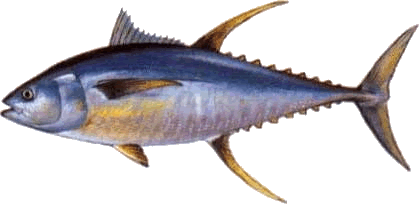 OTHER NAMES: Allison Tuna, AhiRANGE: Mexican Coastal Waters, Eastern Pacific, Carribean OTHER NAMES: Allison Tuna, AhiRANGE: Mexican Coastal Waters, Eastern Pacific, Carribean
HABITAT: The open seas, but frequently near dropoffs.
DESCRIPTION: Distinguishing the Yellowfin Tuna from the Blackfin or Bigeye is sometimes difficult as many visual features are similar. Finlets of the Yellowfin are yellow, trimmed in black. Gold stripe along side. Light underside usually shows spots and/or wavy lines. Second dorsal and anal fins of very large individuals are elongated and lunate - a feature not found on any other Tuna.
SIZE: May run anywhere from a few pounds to more than 200 pounds. Maximum close to 400. World record 388 pounds, 12 ounces; Florida record 230 pounds.
FOOD VALUE: One of the best.
GAME QUALITIES: Second only to Bluefin Tuna, and only because of smaller size.
TACKLE AND BAITS: Heavy outfits are indicated - 50- or 80-pound. But light and medium ocean outfits are often used. Most are probably caught trolling with offshore trolling lures or rigged baits, but in certain areas the best approach is to anchor on a reef near deep blue water and bring in the fish by chumming with Pilchards or similar small baitfish. In that situation they can also be hooked by casting artificial lures with spinning, baitcasting and fly tackle - and landed, if the size is right and luck is with the angler.
FISHING SYSTEMS: Drifting; Still Fishing; Trolling.
Back to Top
WAHOO (Acanthocybium soladri)
 OTHER NAMES: Peto, Ono OTHER NAMES: Peto, Ono
RANGE: Pacific Ocean, Sea of Cortez
HABITAT: Roams the deep blue water, but anglers can find them by working dropoffs, seamounts, weedlines and other favorable feeding locations.
DESCRIPTION: Long, slender body marked with zebra-like stripes of white and deep blue or black. Mouth is elongated and narrow, and equipped with razor-sharp teeth - careful!
SIZE: Common at 10-50 pounds; often grows to 80 or 90 pounds; maximum potential about 150 pounds. World record 158 pounds, 8 ounces.
FOOD VALUE: White meat is tasty but rather dry. A good smoking fish.
GAME QUALITIES: May strike a surface bait in spectacular, greyhounding fashion, but seldom jumps after being hooked. Wild fight is characterized by several sizzling runs, usually at or near the surface. One of the fastest of all gamefish.
TACKLE AND BAITS: Many Wahoo are hooked on heavy tackle, incidentally to Billfishing. Best choices, however, are light to medium ocean trolling outfits with lines up to 30-pound test; 50-pound isn't too heavy for good sport with big specimens. A few have been caught by deep jigging or ocean casting with spinning and baitcasting tackle - even fly tackle on rare occasion. Most productive bait is a weighted feather or similar trolling lure, rigged in combination with a whole small baitfish or large strip. Surface trolling is sometimes effective, but deep trolling is much more likely to produce a Wahoo.
FISHING SYSTEMS: Drifting; Trolling.
Back to Top
|
|
|
|
